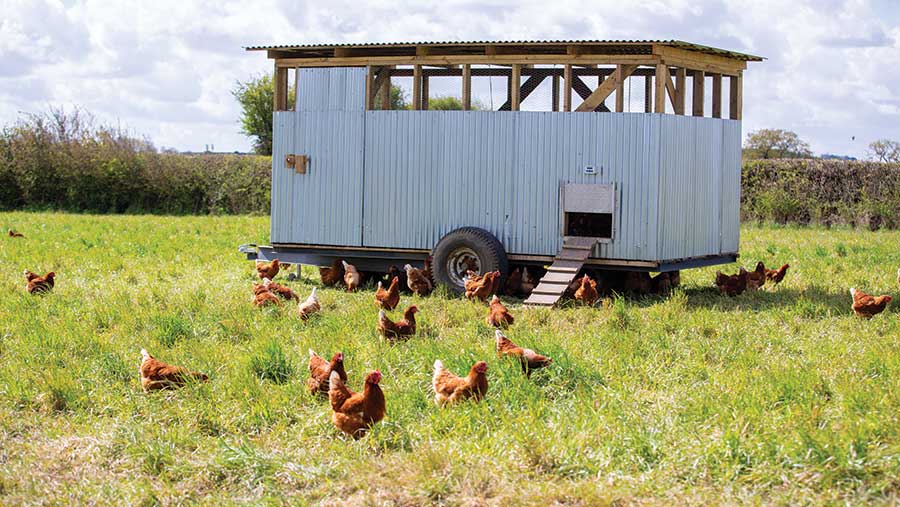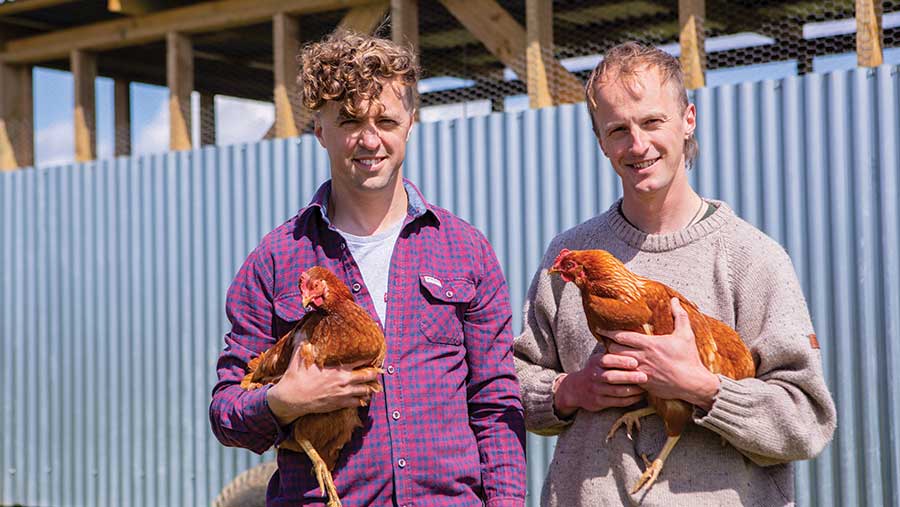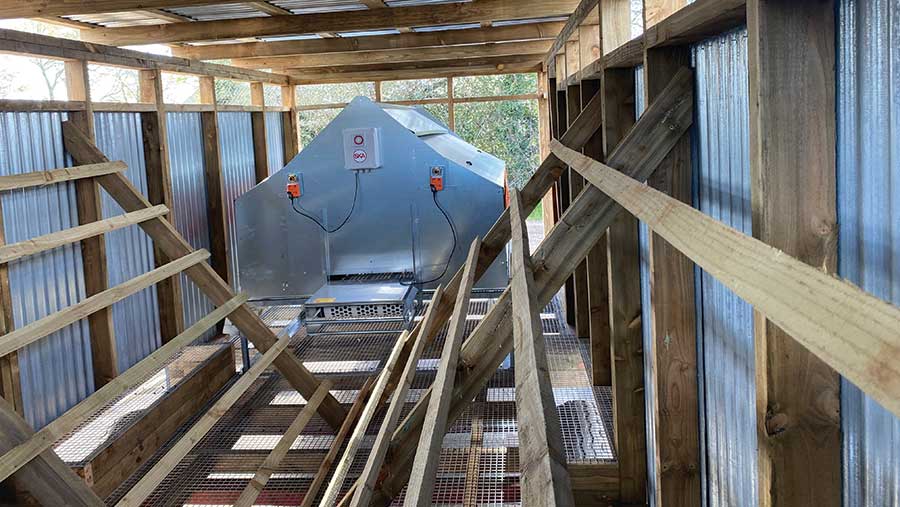Why pastured poultry is good fit for grassland farm
 © Nick Francis
© Nick Francis At Paddock Farm in Warwickshire, 300 Hy-line and Dekalb hens follow beef cattle around the grazing rotation, producing an average of 240 eggs a day.
They apply their manure directly on the land while rooting around in the cowpats for parasitic worm and fly eggs and larvae, roosting in a mesh-floored mobile shed at night.
See also: 5 poultry manure management tactics to protect soils and water
For farmers Nick and Jon Francis, the hens not only perform an important soil and cattle health function but generate egg sales worth £24,000 a year. The eggs attract a price premium, retailing at £8.25 for a tray of 30 or £2.40 for half a dozen.
Although there is £6,000 of supplementary feed to be factored into the sales figure, together with some infrastructure and labour costs, Nick points out: “The egg mobile is a profitable enterprise.”
So much so that a second mobile shed is under construction, to double layer numbers to 600.
Nick and Jon are first-generation farmers who started farming in 2008, lured into the sector by an interest in food and how it is produced.
Through rental agreements, they have gradually increased their grazing area to 141ha (350 acres), producing meat from outdoor-reared pigs, a suckler herd and bought-in stores, and eggs from their flock of layers.
Farm facts: Paddock Farm, Warwickshire
- 80 Aberdeen Angus cross Hereford suckler cows and heifers
- Total of 220 head of cattle on farm, with dairy-bred Hereford stores bought for finishing
- 50 breeding Tamworth sows
- 300 layers, increasing to 600 with second egg mobile
- All produce sold direct to the customer
- Retail and commercial butchery in Brailes, on the Warwickshire/Oxfordshire border

Nick Francis (left) and Jon Francis © Nick Francis
When the brothers decided to introduce pastured poultry into their farming system, they wanted it to be productive and profitable, so they opted for modern genetics – a mix of Hy-Line and Dekalb hens – to supply “aesthetically pleasing’’ trays of brown and white eggs.
The flock achieves 80% lay – in a more conventional system, the laying percentage would be greater, says Nick.
To realise their genetic potential, the hens require supplementary feed – a 120g/head daily ration of 18% protein layer pellets.
Although they get some nutrients from insects and predatory fly larvae, most of their nutritional requirements come from the pellets.
Nick points out that the principal purpose of having the flock at grass is not to sustain them on pasture and insects, but to break down the cattle manure while foraging for parasites, to benefit the soil and livestock health.

Inside the egg mobile – the auto-exclusion nesting boxes are solar-powered © Nick Francis
Housing in the grazing season
Night-time housing is a towable shed, home-made and constructed from timber on the chassis of a redundant low-loader.
It sits within a 50x25m enclosure made from electric net fencing, with the shed moved daily and the enclosure weekly.
The shed, which Nick and Jon refer to as the egg mobile, is based on a design by US regenerative farmer Joel Salatin, adapted from his blueprint to protect the flock against predation and to minimise labour input.
It initially had a slatted floor. However, it had been in use for only one night when it became clear this was not suitable for an area with a fox population: the hens had been attacked from underneath.
The slats were replaced with fox-proof wire mesh, and two Maremma sheepdogs – a breed specifically bred as livestock guardians – were drafted in to fortify defences further.
The dogs occupy the fenced area and keep the chickens safe from predation.
To minimise labour input, the mobile has auto-exclusion nesting boxes powered by a 12V solar panel.
This excludes the hens from the boxes from dusk to dawn to prevent dirty shells.
The egg mobile is moved every morning when the chickens are also fed, and the eggs are collected in the afternoon; Nick estimates that those jobs in combination take an hour.
Pasture management
There is an additional weekly labour requirement of one hour to move the netting.
The moves are carefully managed because the hens are aggressive scratchers and can dig up plants if they are kept in one place for too long.
Manure deposited in situ by the hens, cattle and pigs, and applications of farmyard manure or compost, are the only nutrients applied to the grassland.
Although Nick and Jon do not have data to back up the beneficial effects the hens have on soils, they are confident they are helping to build soil health.
“We pull the mobile across the field and if we return to that spot six weeks later, there is an incredibly lush green section beneath where the mobile was: the pasture really thrives on it,” says Nick.
By managing moves so that each section of the grazing rotation is occupied by the mobile only once every 45 days or so, the poultry manure does not deliver a nutrient overload, he adds.
In addition, because the mobile is portable, it can be used to target areas of the farm that are short of nutrients.
Cattle health has also benefited: since having hens in the rotation, faecal egg counts have shown no worm burden in the cattle, so they have not needed any wormer treatments.
“We don’t want to be risking insecticides on our pastures either, but we would spot treat if needed,” says Nick.
Winter housing
The requirement of moving the mobile easily each day means its footprint cannot be too large.
However, this also means it is not suitable as permanent housing.
So, when the grazing season ends, usually in November, the hens are housed in polytunnels on the farm’s market garden.
“Once the vegetable crops come out, the chickens spend the winter in the polytunnels and add lots of fertility before they are turned out again in the spring,” says Nick.
Avian influenza housing orders have created some challenges, he admits, with turnout delayed this year. “We had plants in the propagator, and they were ready to plant as soon as the housing order was lifted.
“If we didn’t have the polytunnels, we would need some form of undercover shelter for the hens in the winter.”
Limitations
The shed size also means the eggs cannot carry the Animal and Plant Health Agency’s egg marketing inspector’s stamp, as the regulations require a maximum of nine hens/sq m of usable floor area.
These regulations have not been designed with portable housing in mind, says Nick.
“The regulations are absolutely appropriate for large-scale, static, free-range systems but are simply not fit for purpose for small scale portable setups,” he reckons.
Some countries, including Sweden, have introduced derogations to address this as chicken mobiles have become more common.
The absence of that stamp restricts sales to a farmer’s own farm or retail premises, but as Nick points out: “I am selling eggs with a clear conscience on welfare and food safety standards. Our chickens have a fantastic life.”